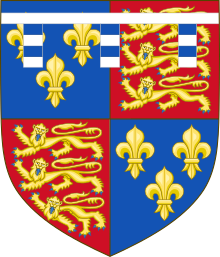Edward Plantagenet, 17th Earl of Warwick
| Edward Plantagenet | |
|---|---|
| 17th Isabel Neville |
Edward Plantagenet, 17th Earl of Warwick (25 February 1475 – 28 November 1499) was the son of
Life

Edward Plantagenet was the son of
In 1480,[3] Warwick was made a ward of King Edward IV's stepson, Thomas Grey, 1st Marquess of Dorset, who as his guardian had the power to decide whom he would marry.[4] Clements Markham, writing in 1906,[5] claimed that Richard III had "liberated" Warwick from the Tower of London, where Dorset had placed him; however, there are no contemporary sources for this claim, although Dorset was Constable of the Tower. Dominic Mancini wrote that Richard, on becoming king, "gave orders that the son of the duke of Clarence, his other brother, then a boy of ten years old, should come to the city: and commanded that the lad should be kept in confinement in the household of his wife".
Imprisonment and execution
Following the death on 16 March 1485 of Richard III's queen, Anne, young Edward Plantagenet was vested as Earl of Salisbury by right of his mother Isabel, who had been a co-heiress with Anne to the abeyant earldom.[7] This provided Edward and thus his wards with more wealth and potential power. Following King Richard's death on 22 August 1485, Warwick, only ten years old, was kept as a prisoner in the Tower of London by Henry VII acting as his ward. His claim to the throne, albeit tarnished, remained a potential threat to Henry, particularly after the appearance of the pretender Lambert Simnel in 1487. In 1490, he was confirmed in his title of Earl of Warwick despite his father's attainder (his claim to the earldom of Warwick being through his mother). But he remained a prisoner until 1499, when he became involved (willingly or unwillingly) in a plot to escape with Perkin Warbeck.
On 21 November 1499, Warwick appeared at Westminster for a trial before his peers, presided over by John de Vere, 13th Earl of Oxford. A week later, Warwick was beheaded for treason on Tower Hill. Henry VII paid for his body and head to be taken to Bisham Abbey in Berkshire for burial,[8] using funds derived from Warwick's estate. It was thought at the time that Warwick was executed in response to pressure from Ferdinand II of Aragon and Isabella I of Castile, whose daughter, Catherine of Aragon, was to marry Henry's heir, Arthur. Catherine was said to feel very guilty about Warwick's death, and believed that her trials in later life were punishment for it.[9]
A number of historians have claimed that Warwick had a mental disability. This conclusion appears entirely based on the chronicler Edward Hall's contention that Warwick's lengthy imprisonment from a young age had left him "out of all company of men, and sight of beasts, in so much that he could not discern a goose from a capon."[10]
Upon Warwick's death, the House of Plantagenet became extinct in the legitimate male line. However, the surviving sons of his aunt Elizabeth, Duchess of Suffolk, continued to claim the throne for the Yorkist line.
Ancestors
| Ancestors of Edward Plantagenet, 17th Earl of Warwick | ||||||||||||||||||||||||||||||
|---|---|---|---|---|---|---|---|---|---|---|---|---|---|---|---|---|---|---|---|---|---|---|---|---|---|---|---|---|---|---|
| ||||||||||||||||||||||||||||||
Further reading
- Amin, Nathen (15 April 2021). Henry VII and the Tudor Pretenders: Simnel, Warbeck, and Warwick. Amberley Publishing Limited. ISBN 978-1-4456-7509-1.
References
- ISBN 978-0-7083-2189-8.
- Oxford Dictionary of National Biography, Oxford University Press, 2004; online edn, Jan 2008
- ^ Calendar of the Patent Rolls, 1476-1485, p212
- ISBN 0300073720
- ^ Richard III, His Life and Character
- ^ Hazel Pierce, Margaret Pole, Countess of Salisbury 1473-1541 (University of Wales Press, 2009), p. 9.
- ^ Chisholm, Hugh, ed. (1911). . Encyclopædia Britannica. Vol. 24 (11th ed.). Cambridge University Press. p. 72.
- ^ Ian Arthurson, The Perkin Warbeck Conspiracy, 1491-1499 (Sutton, 1997), p. 215.
- ^ The Life of Jane Dormer, Duchess of Feria, preface: "She applied these miseries and disasters to have specially happened for the death of Prince Edward Plantagenet, son of the Duke of Clarence, brother to King Edward the Fourth; whom (most innocent) Henry VII. put to death to make the kingdom more secure to his posterity, and to induce King Ferdinand to give his daughter, this Catharine, in marriage to Prince Arthur".
- ^ Pierce, p. 23.
